The station wagon version of Astra, Opel calls it Sports Tourer, received all the technological upgrades we already know from the hatchback model. Luggage compartment, if we measure it in liters, is not the largest in the class, but the cabin and trunk are spacious. With 190 kilograms less (compared to the predecessor) new 2016 Opel Astra Sports Tourer drives side by side with the best in class.
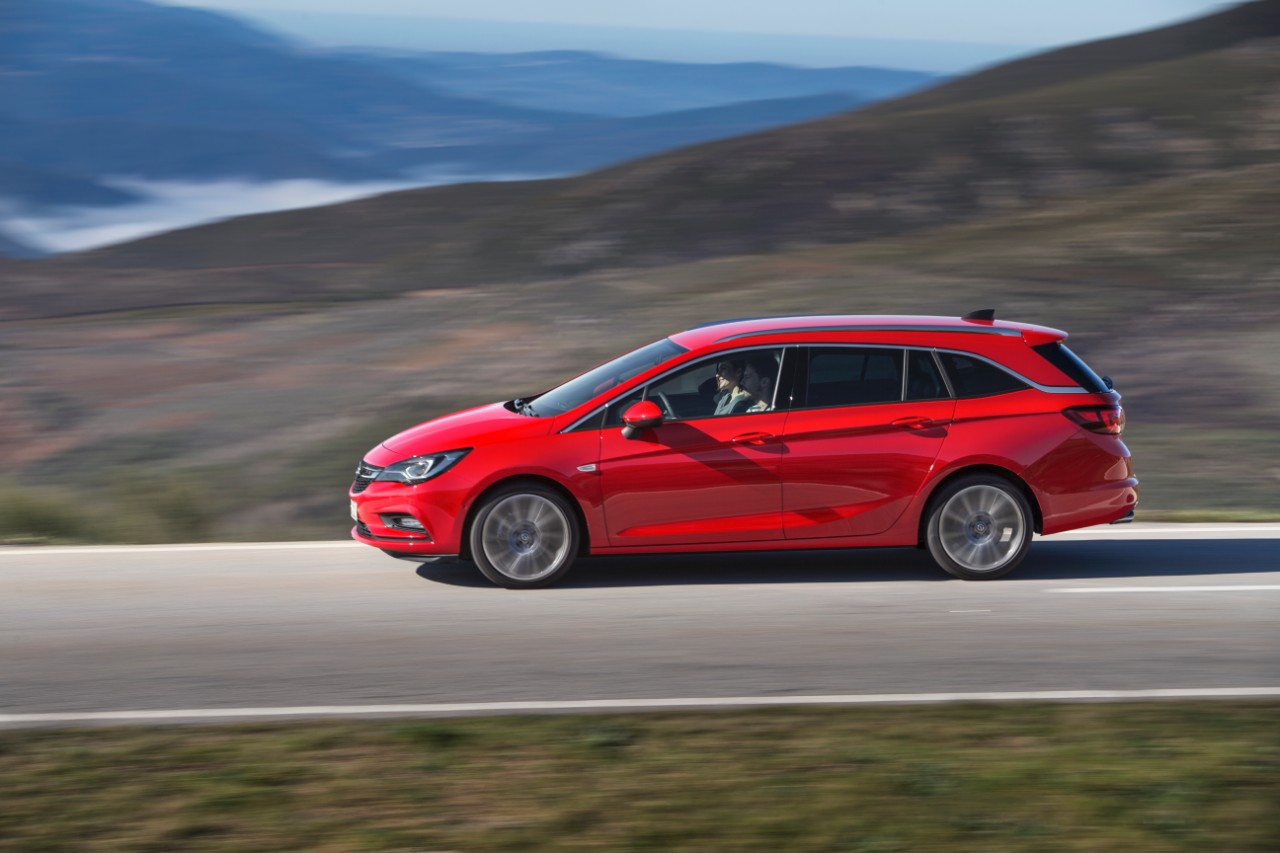
Opel engineers have done a great job, leap from the previous to the new generation is huge.
Opel Astra Sports Tourer Highlights
Predecessors
1st generation 1963 Kadett A, 2nd generation 1965 Kadett B, 3rd generation 1973 Kadett C, 4th generation 1979 Kadett D, 5th generation 1984 Kadett E, 6th generation 1991 Astra F, 7th generation 1998 Astra G, 8th generation 2004 Astra H, 9th generation 2010 Astra J.
Production
Ellesmere Port (United Kingdom), Gliwice (Poland).
Start of sales
Spring 2016.
Price
From around 15,000 euros.
Opel Astra Sports Tourer main Highlights:
– Lighter, slightly more spacious and firmer body, overall weight reduced by 190 kilograms.
– 540 liters of luggage compartment, 1,630 liters with folded rear seats.
– Electrically opening and closing tailgate with hands-free sensor (kick under the rear bumper).
– 8-inch touch screen in the center console, fewer buttons and switches for greater transparency, simplicity and accuracy.
– A comprehensive set of advanced safety assistance systems: Opel Eye camera with extended functions for recognizing traffic signs, lane control assist, automatic emergency braking, a system for monitoring blind spots, advanced parking assist, reversing camera…
– Three- and four-cylinder gasoline and diesel engines with a capacity from 1.0 to 1.6 liters and a power range from 95 to 200 horsepower; new, very good biturbo 1.6-liter CDTI diesel with 160 hp, 350 Nm of torque and 4.1-liter average fuel consumption (109 g/km CO2).
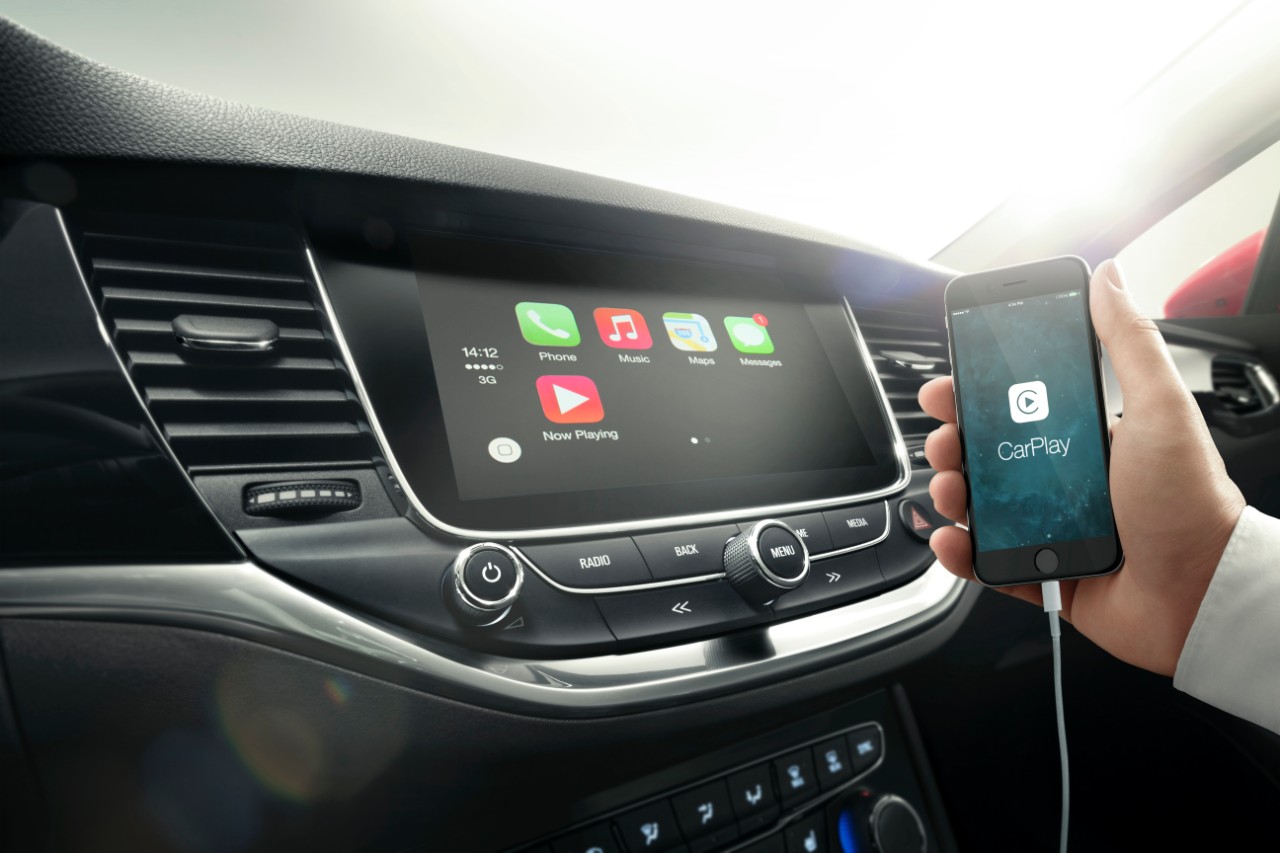
8-inch touch screen in the center console, fewer buttons and switches
Reduced weight is good in many ways
Opel Astra Sports Tourer was, like the hatchback, sent on a diet. Depending on the engine, the new model is up to 190 kilograms lighter than the predecessor. Weight has been reduced by using high-strength steel, the seats are 10 kilograms lighter, the exhaust weight is reduced and the wheels are smaller. All this means not only lower cost of ownership, but also in all segments of driving. At the same time new Sports Tourer, unlike many competing models, preserved the external dimensions unchanged.
The car has a bunch of new technologies. LED matrix headlights are not only trendy, but they are a great safety device for driving at night, which makes it more comfortable. The speed limits recognition system (which monitors traffic signs) works perfectly. 8-inch touch screen, which is part of the new infotainment system is graphically well-polished. The image that is displayed by the camera at the rear of the vehicle offers good visibility although a 360-degree view, which is slowly coming in this vehicle segment, is not offered. The OnStar system, known from hatchback, works.
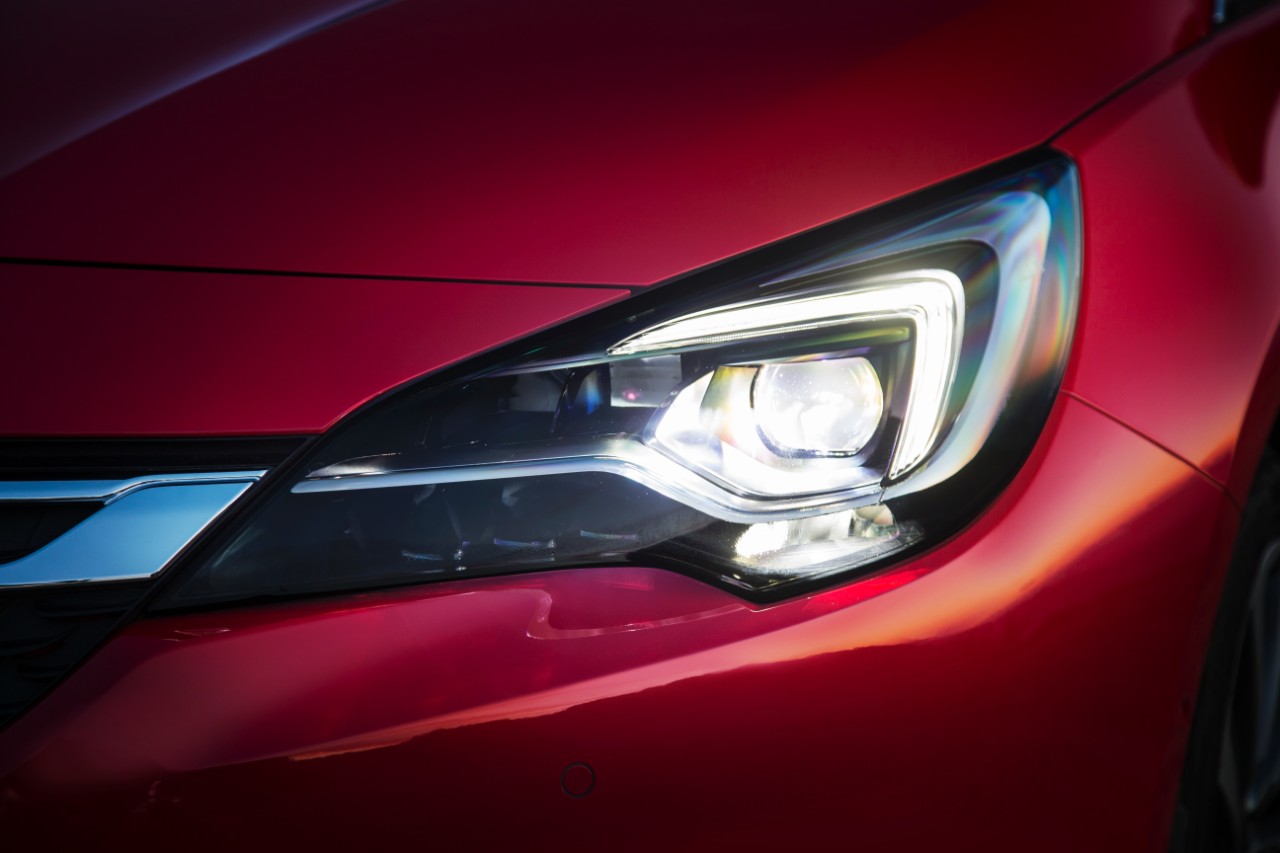
LED matrix headlights are not only a trend, but they are a great safety device for driving at night
New Astra is now one of the best in class in driving dynamics
The chassis is solid and quiet, by pressing the sport switch the steering wheel becomes more sporty stiff. Like the hatchback relative, Opel Astra Sports Tourer is also very easy to drive. Among the curves we notice a lightness without any significant tilting, even over the rolling sections the ride is nice, steering is direct enough.
Opel engineers have done a great job, leap from the previous to the new generation is huge. From the driving dynamics perspective Astra is certainly competitive with the best in class, the VW Golf and Ford Focus.
Did Opel Astra finally caught Volkswagen Golf?
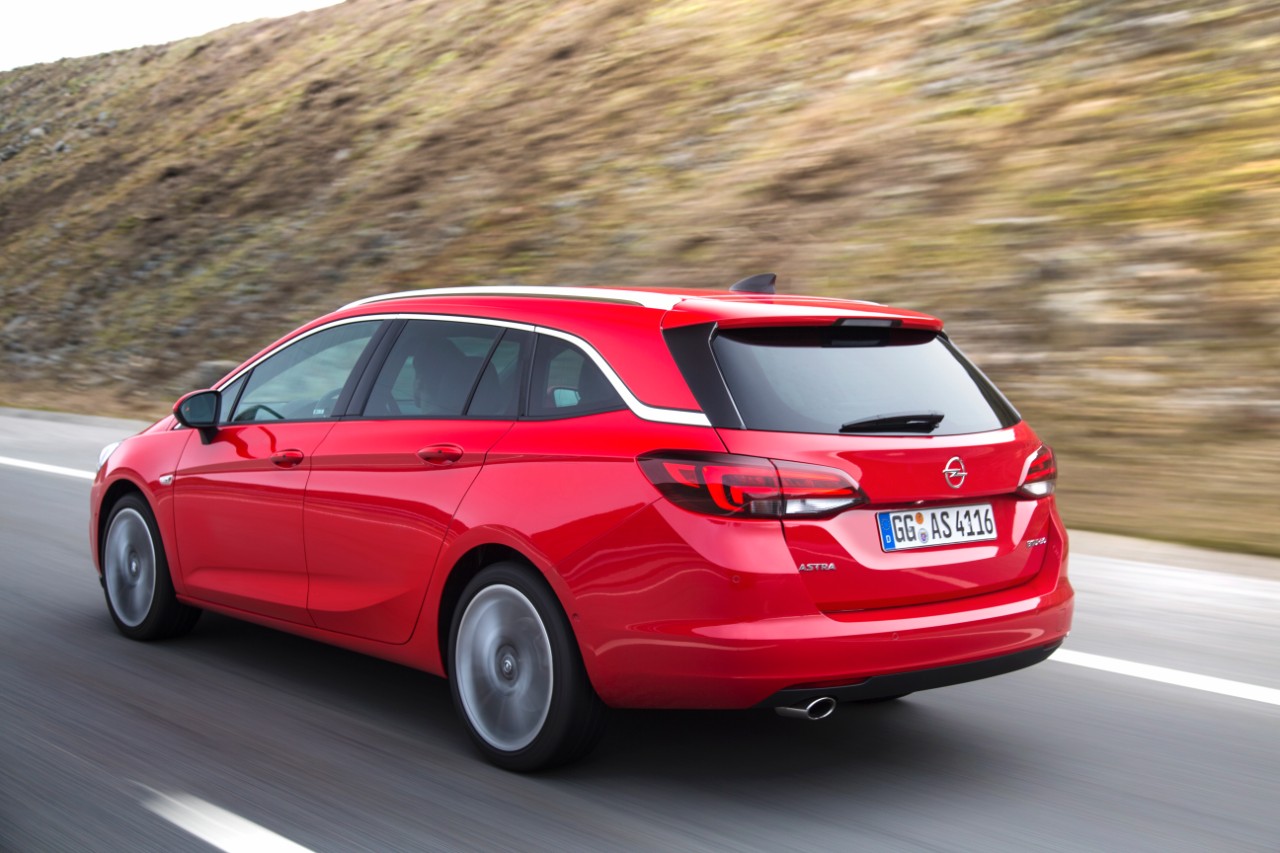
They finally caught Volkswagen Golf, particularly with driving dynamics, economy and value for the money.
New Astra, introduced last year, is one of the best cars in its class. This is confirmed by numerous awards, including the title of European Car of the Year 2016 – where Astra overcame numerous distinguished competitors, also from the premium class.
With Astra, Opel managed to build something, that was planned for generations. They finally caught Volkswagen Golf, particularly with driving dynamics, economy and value for the money. And not only that. New 2016 Astra is even better in some segments, in particular in the field of comfort, cost of ownership, and partially also in technologies, such as the great LED matrix headlights. In Europe, every fourth astra is equipped with LED matrix headlights.
Opel Astra Sports Tourer is most desirable Astra
The Opel Astra Sports Tourer is one of the most steerable station wagons at the moment in its segment. Above all, it represents a major leap forward, not only in driving dynamics, but also in the spaciousness and flexibility compared to the previous generation. How important is the station wagon body type, can be best illustrated by figures. In some markets, almost 50 percent of all Astra’s sold are the station wagon, next favorite option are hatchbacks and only a few percent comes to the buyers as the four-door sedan.
New Astra exterior: evolution, not revolution
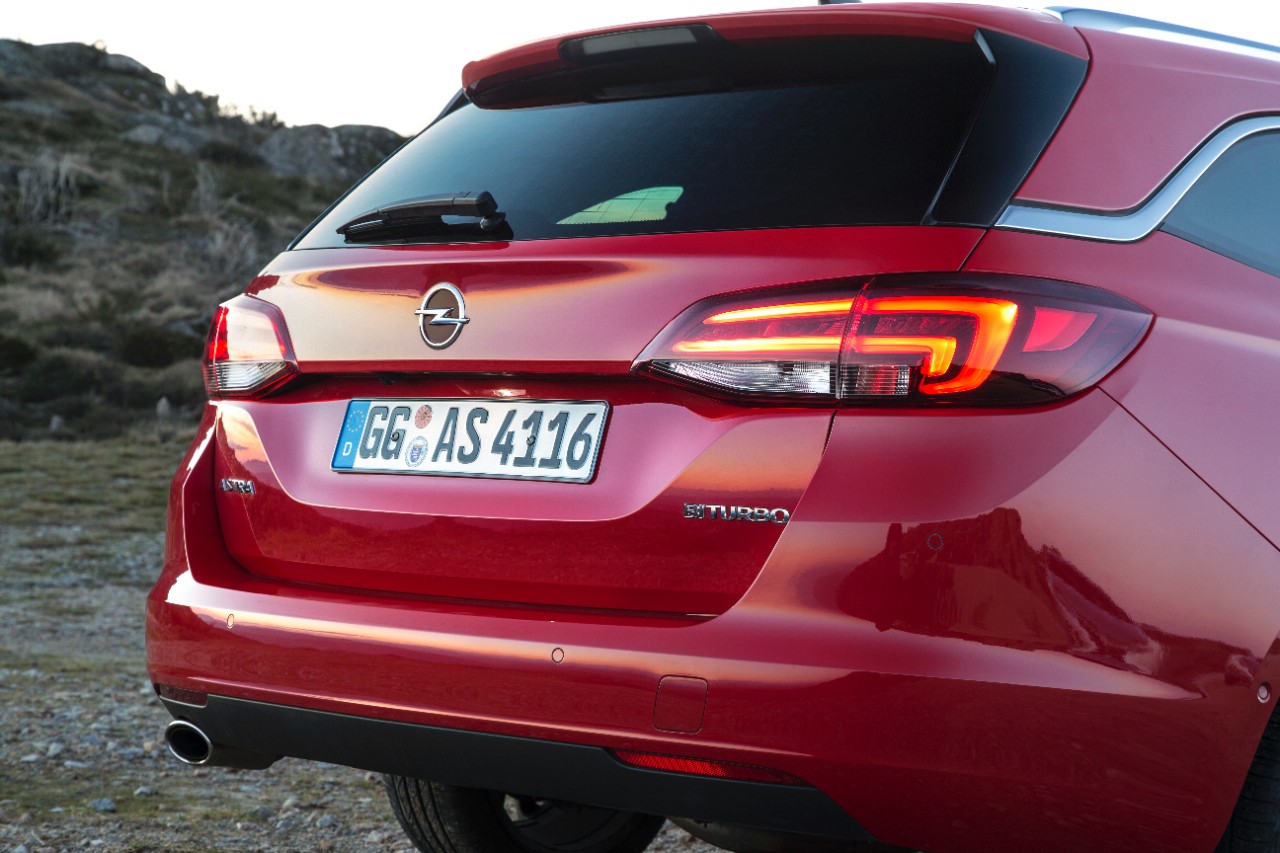
In some markets, almost 50 percent of all Astra’s sold are the station wagon
The design of the front of the vehicle complies with the hatchback, while the rear end substantially increased compared to its predecessor. New Opel Astra Sports Tourer design does not bring revolution, we could say it is the designer evolution of its predecessor. This is not necessarily a bad thing. Again, let us take the VW Golf for comparison, where we wonder from generation to generation, how it is different from its predecessor? But the customers clearly appreciate this, because when a new generation model reaches the market, we never had the feeling that we drive an old vehicle. We will see whether it will do so in the case of the Astra.
At the forefront of the Opel Astra Sports Tourer is the caravan rear part and family or commercial usefulness. Chrome frame and spoiler cleverly disguises boxlike shape and made a very athletic appearance. The tailgate is designed intelligently. Loading opening is very wide, the lines are correctly formatted, so the load of bulky objects or pieces of luggage can be done quite easily. Very low loading level and an electrically-operated tailgate additionally contributes to the usefulness of the luggage compartment. The tailgate can be opened with the “kick” under the bumper.
Folding seats with the button
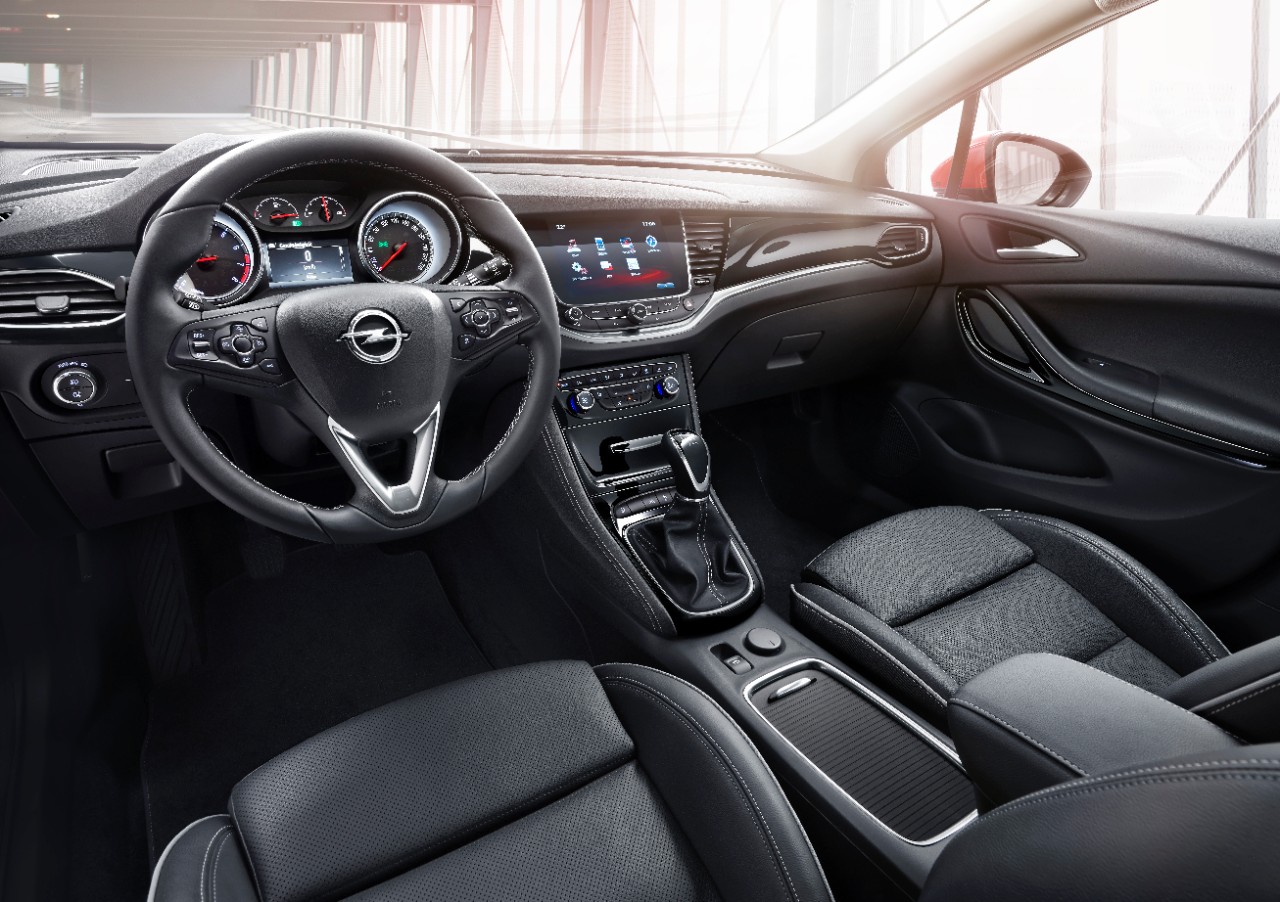
The cabin is more spacious that in the predecessor model.
The rear bench has three seats, that can be folded at the touch of a button in the trunk. With that we get a completely flat bottom of the trunk. The rear seats are fitted with two ISOFIX connectors, for two child seats, rather than three, although it is relatively wide. Seats collapses in a ratio of 40:20:40, while the center seat can also be used as an arm rest, or a place to put a cup of coffee. The rear seat is not longitudinally movable. At Opel they admit that this is otherwise an excellent solution for increasing the luggage compartment, but the system is massive and heavy, which affects both the total weight, emissions, fuel consumption and ultimately the driving dynamics.
Opel Astra Sports Tourer can be equipped with a small spare wheel at the bottom of the trunk or it can have a tire repair kit. In the second case we get a lot of additional storage space for transporting small items.
The size of the boot puts Opel Astra Sports Tourer in the class average
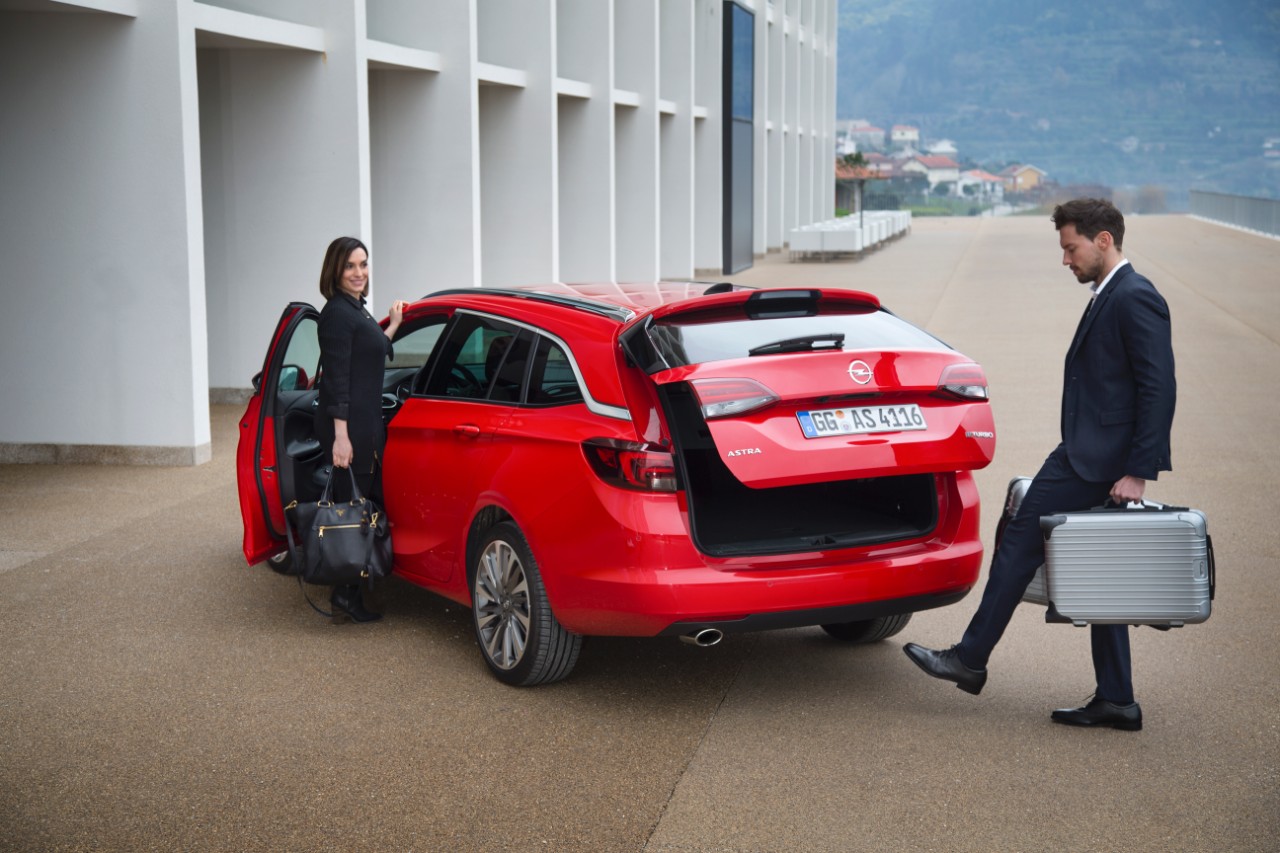
The tailgate can be opened with the “kick” under the bumper.
In the technical characteristics it is stated that luggage compartment capacity is 540 liters, or 1,630 liters when the seats are folded. This means 80 liters more than the previous Astra model, but also 70 liters less than the Skoda Octavia and nearly 40 liters more than the Ford Focus. Honda Civic Wagon defeats all with the 624-liter luggage compartment.
Liters are important, but it is also important how the space is utilized. Opel Astra Sports Tourer, if you look it from the side, looks very dynamic, a spoiler at the rear contribute to this. Nevertheless, the trunk is large and enables easy loading. It also incorporates a number of useful accessories such as separating rods, hooks for hanging bags and clothes, drawers…
Equally important as the load compartment capacity is the space in the cabin. New Astra hatchback is shorter but more spacious in the cabin than its predecessor, because of the new platform. In the wagon version the wheelbase measured in centimeters is the same as in the previous model, additional centimeter are rather devoted to the trunk. Nevertheless, there is considerably more space in the cabin because of the new design of the seats, which are thinner, and some other technical solutions. In the second row there is plenty of room for knees and head, even for a person with a height of 190 centimeters.
The brand new 1.6-liter biturbo diesel engine
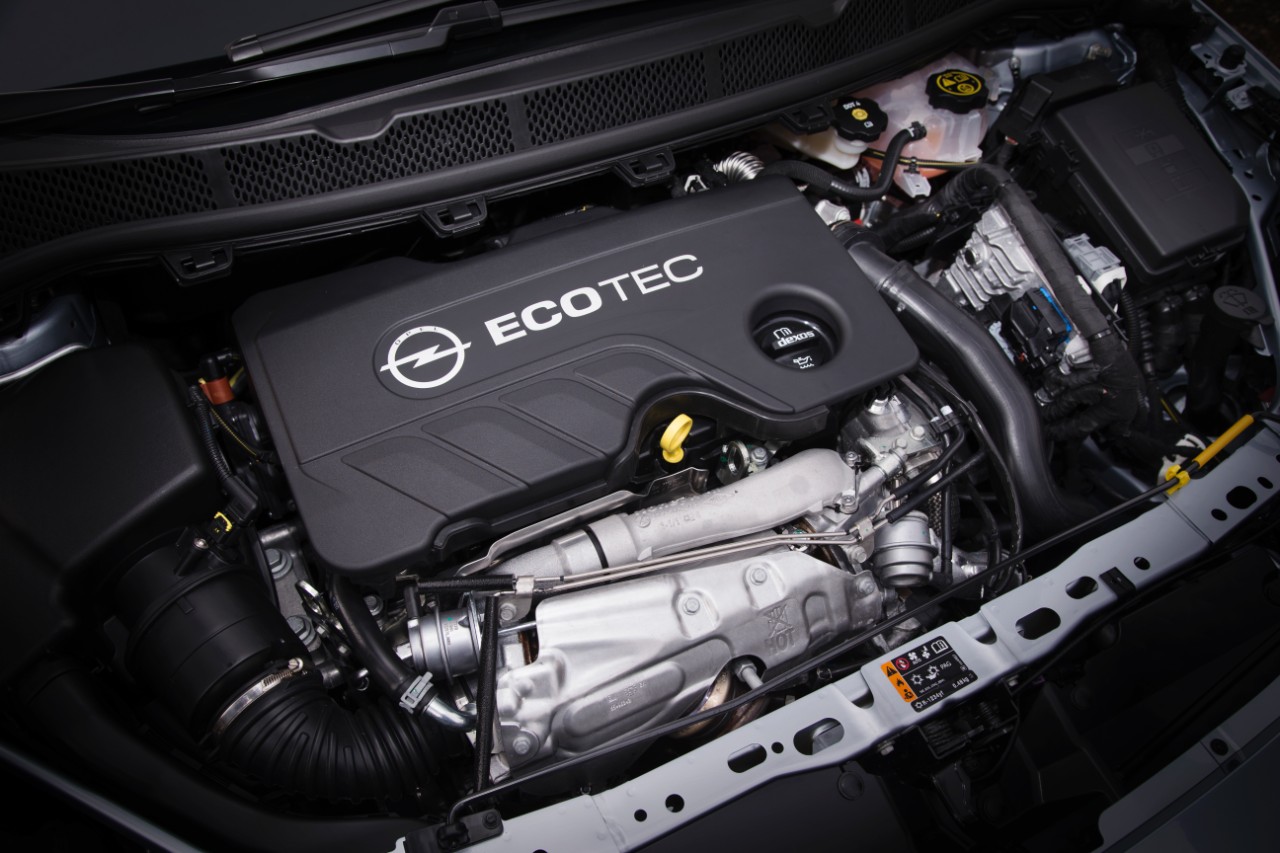
The most interesting is the brand new 1.6-liter turbo diesel engine with 160 hp and 350 Nm of torque.
Like the hatchback, the Sports Tourer is also available with a wide range of turbo gasoline and diesel engines, with three or four-cylinder. The most interesting is the brand new 1.6-liter turbodiesel engine with 160 hp and 350 Nm of torque. It replaces the two-liter engine and represents the top offer in 2016 Opel Astra Sports Tourer and also hatchback engine range.
The specificity of the engine are two turbochargers. First, smaller one, takes care of a faster response at low revs. 320 Nm of torque is available from 1,250 rpm onwards, all the torque from 1,500 rpm onwards. A larger turbocharger takes over the role immediately after the start and make sure that there is enough torque to accelerate up to 4,500 rpm. In practice, this is reflected in the better start from standstill, the engine is more responsive, very flexible, with less gear shifting.
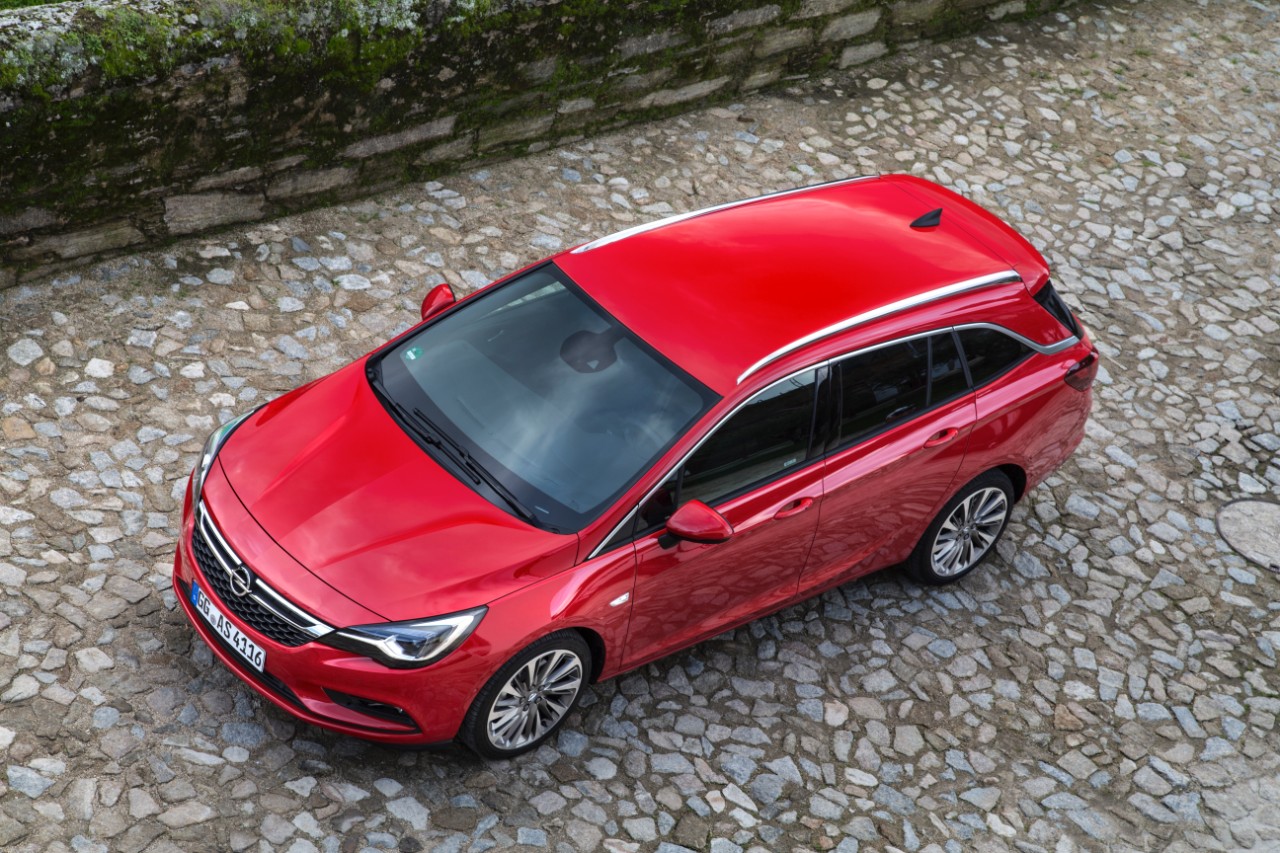
Diesel noise in the cabin is not disturbing and can almost not be heard.
Above all, progress is being made in the fuel economy. The factory claims that the average consumption in the combined cycle is 4.1 liters per 100 kilometers. In practice this figure cannot be achieved, but calm driving can get you to an average of five liters, which is low for such a powerful car. More importantly, it seems that the average consumption of the dynamic driving, including uphill acceleration and overtaking, of 5.8 liters of diesel per 100 kilometers, is more that decent.
The advantage of this engine is also that it is smooth. Diesel noise in the cabin is not disturbing and can almost not be heard. Even on the highway the noise insulation is very good. Six-speed manual gearbox feels compact, it is not among the most precise on the market, and has a well-distributed gear ratios, since it allows both sporty and economical shifting.
Four diesel and five petrol engine options
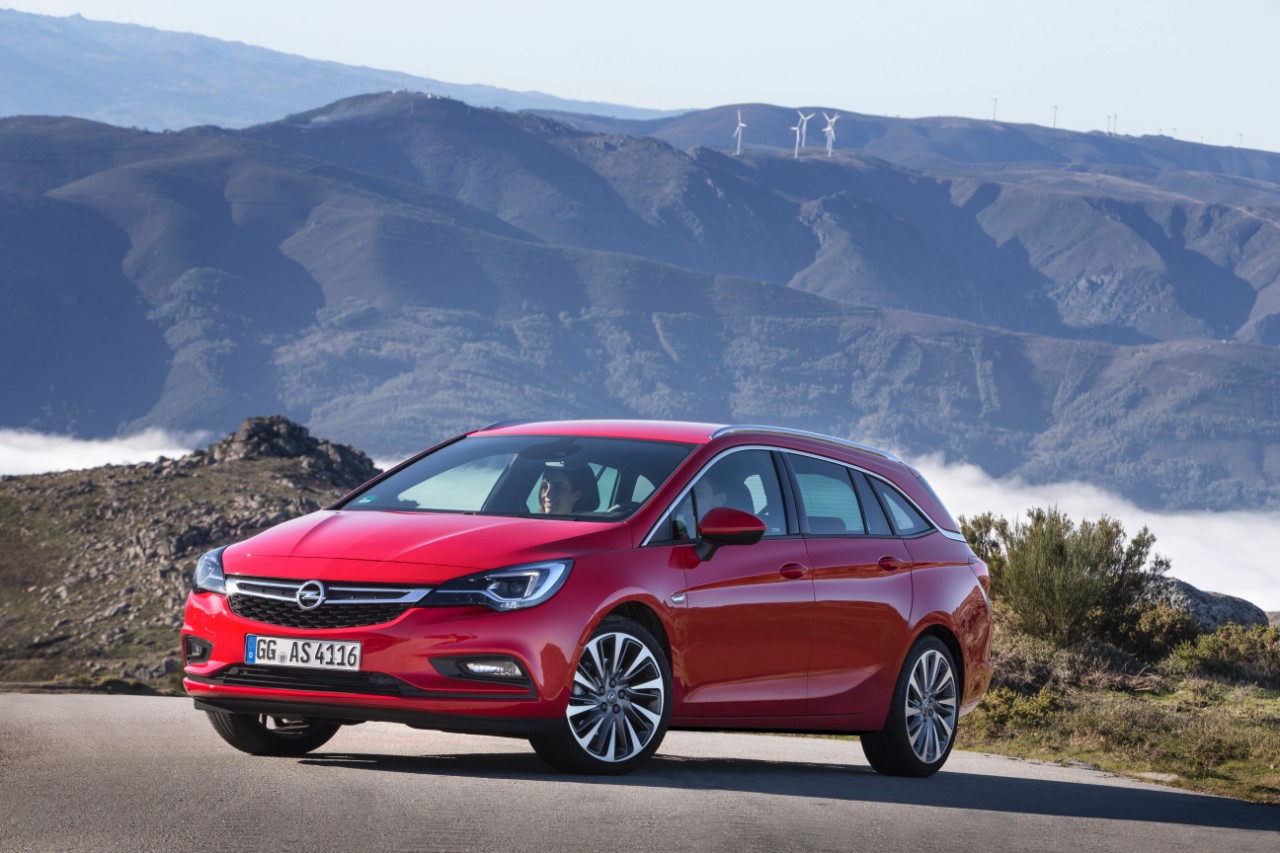
New Astra design does not bring revolution, we could say it is the designer evolution of its predecessor.
The diesel offer in the Opel Astra Sports Tourer consists of four power levels, all based on the similar 1.6-liter displacement. The power range starts with 95 hp and continues through 110 hp and 136 hp variant. The top offer is above mentioned 160 hp engine.
Five different gasoline engines are available for the new Astra Sports Tourer, including the all-aluminum 1.0 ECOTEC Direct Injection Turbo and the 1.4-liter, four-cylinder turbo. The top-of the-range engine available for the Astra Sports Tourer is 1.6 ECOTEC Direct Injection Turbo with 200 hp and 300 Nm of torque.
2016 Opel Astra Sports Tourer technical details
Dimensions
Compact station wagon, 5 seats, 5 doors.
Length: 4702 mm.
Width: 2042 mm (with rear-view mirrors).
Height: 1510 mm.
Wheelbase: 2662 mm.
Luggage compartment: from 540 to 1,630 liters.
Turning circle diameter: 11.05 meters (from wall to wall).
Dimension of tires: 195/65 R15 or 205/55 R16 or 225/45 R17 or 225/40 R18.
Towing capacity: 670 kg (trailer without brakes) to 1500 kg (inertia)
Permissible roof load: 75 kg.
Fuel tank: 48 liters.Engine options
1.0 ECOTEC turbo
gasoline 3-cylinder turbo engine with direct injection; volume: 999 cm3; power: 105 hp at 5500 rpm; torque: 170 Nm from 1800 to 4250 rpm; 5-speed manual transmission; front-wheel drive; mass: 1288 kg, top speed: 195 km/h; acceleration (0-100 km/h): 11.2 s; consumption: 4.3 to 4.5 l/100 km; CO2 emissions: 100 to 103 g/km; EURO 6; est. price: 17,000 EUR.
1.0 ECOTEC turbo Easytronic
gasoline 3-cylinder turbo engine with direct injection; volume: 999 cm3; power: 105 hp at 5500 rpm; torque: 170 Nm from 1800 to 4250 rpm; 5-speed automated (robotic) transmission Easytronic; front-wheel drive; weight: 1,288 kg, top speed: 200 km / h; acceleration (0-100 km/h): 12.9 s; consumption: 4.2 to 4.3 l/100 km; CO2 emissions: 97 to 100 g/km; EURO 6; est. price: 17,600 EUR.
1.4 ECOTEC
gasoline 4-cylinder atmospheric engine; volume: 1399 cm3; power: 100 hp at 6000 rpm; torque: 130 Nm at 4300 rpm; 5-speed manual transmission; front-wheel drive; mass: 1273 kg; top speed: 185 km/h; acceleration (0-100 km/h): 12.3 s; consumption: 5.5 to 5.7 l/100 km; CO2 emissions: 127 to 131 g/km; EURO 6; est. price: 15,700 EUR.
1.4 ECOTEC turbo
gasoline 4-cylinder turbo engine with direct injection; volume: 1399 cm3; power: 125 hp from 4000 to 5600 rpm; torque: 245 Nm from 2000 to 3500rpm; 6-speed manual transmission; front-wheel drive; mass: 1322 kg, top speed: 205 km/h; acceleration (0-100 km/h): 9.6 s; consumption: 5.6 l/100 km; CO2 emissions: 130 g/km; EURO 6; est. price: 17,500 EUR.
1.4 ECOTEC turbo ecoFLEX (start / stop)
gasoline 4-cylinder turbo engine with direct injection; volume: 1399 cm3; power: 125 hp from 4000 to 5600 rpm; torque: 230 Nm from 2000 to 3500 rpm; 6-speed manual transmission; front-wheel drive; mass: 1322 kg, top speed: 205 km/h; acceleration (0-100 km/h): 9.9 s; consumption: 5.1 l/100 km; CO2 emissions: 117 g/km; EURO 6; est. price: 17,700 EUR.
1.4 ECOTEC Turbo
gasoline 4-cylinder turbo engine with direct injection; volume: 1399 cm3; power: 150 hp from 5000 to 5600 rpm; torque: 245 Nm from 2000 to 4000 rpm; 6-speed manual transmission; front-wheel drive; mass: 1322 kg, top peed: 215 km/h; acceleration (0-100 km/h): 8.7 seconds; consumption: 5.6 l/100 km; CO2 emissions: 130 g/km; EURO 6; est. price: 18,100 EUR.
1.4 ECOTEC turbo ecoFLEX (start / stop)
gasoline 4-cylinder turbo engine with direct injection; volume: 1399 cm3; power: 150 hp from 5000 to 5600 rpm; torque: 230 Nm from 2000 to 4000 rpm; 6-speed manual transmission; front-wheel drive; mass: 1322 kg, top speed: 215 km/h; acceleration (0-100 km/h): 8.9; consumption: 5.1 l/100 km; CO2 emissions: 117 g/km; EURO 6; est. price: 18,400 EUR.
1.4 ECOTEC turbo ecoFLEX (start / stop) automatic
gasoline 4-cylinder turbo engine with direct injection; volume: 1399 cm3; power: 150 hp from 5000 to 5600 rpm; torque: 230 Nm from 2000 to 4000 rpm; 6-speed automatic transmission; front-wheel drive; mass: 1350 kg, top speed: 210 km/h; acceleration (0-100 km/h): 9.4 s; consumption: 5.6 l/100 km; CO2 emissions: 128 g/km; EURO 6; est. price: 19,600 EUR.
1.6 ECOTEC turbo (start / stop)
gasoline 4-cylinder turbo engine with direct injection; volume: 1598 cm3; power: 200 hp from 4700 to 5500 rpm; torque: 300 Nm from 1700 to 4700 rpm; 6-speed manual transmission; front-wheel drive; mass: 1393 kg; top speed: 235 km/h; acceleration (0-100 km/h): 7.7 s; consumption: 6.2 l/100 km; CO2 emissions: 142 g/km; EURO 6; est. price: 21,500 EUR.
1.6 CDTI
diesel 4-cylinder turbo engine; volume: 1598 cm3; power: 95 hp at 3500 rpm; torque: 280 Nm from 1500 to 1750 rpm; 6-speed manual transmission; front-wheel drive; mass: 1388 kg; top speed: 185 km/h; acceleration (0-100 km/h): 12.9 s; consumption: 3.8 l/100 km; CO2 emissions: 99 g/km; EURO6; est. price: 18,300 EUR.
1.6 CDTI
diesel 4-cylinder turbo engine; volume: 1598 cm3; power: 110 hp at 3500 rpm; torque: 300 Nm from 1750 to 2000 rpm; 6-speed manual transmission; front-wheel drive; mass: 1403 kg; top speed: 195 km/h; acceleration (0-100 km/h): 11.4 s; consumption: 3.8 l/100 km; CO2 emissions: 99 g/km; EURO6; est. price: 18,800 EUR.
1.6 CDTI ecoFLEX (start / stop)
diesel 4-cylinder turbo engine; volume: 1598 cm3; power: 110 hp at 3500 rpm; torque: 300 Nm from 1750 to 2000 rpm; 6-speed manual transmission; front-wheel drive; mass: 1403 kg; top speed: 195 km/h; acceleration: 11.4 s (0-100 km/h); consumption: 3.6 l/100 km; CO2 emissions: 95 g/km; EURO6
1.6 CDTI (start / stop)
diesel 4-cylinder turbo engine; volume: 1598 cm3; power: 136 hp to 3500 to 4000 rpm; torque: 320 Nm from 2000 to 2250 rpm; 6-speed manual transmission; front-wheel drive; mass: 1403 kg; top speed: 205 km/h; acceleration (0-100 km/h): 10.1 s; consumption: 3.9 l/100 km; CO2 emissions: 104 g/km; EURO6; est. price: 19,600 EUR.
1.6 CDTI (start / stop) automatic
diesel 4-cylinder turbo engine; volume: 1598 cm3; power: 136 hp to 3500 to 4000 rpm; torque: 320 Nm from 2000 to 2250 rpm; 6-speed automatic transmission; front-wheel drive; mass: 1425 kg; top speed: 200 km/h; acceleration (0-100 km/h): 10.1 s; consumption: 4.6 l/100 km; CO2 emissions: 122 g/km; EURO6; est. price: 20,300 EUR.
1.6 CDTI BiTurbo
diesel 4-cylinder biturbo engine; volume: 1598 cm3; power: 160 hp at 4000 rpm; torque: 350 Nm from 1500 to 2250 rpm; 6-speed manual transmission; front-wheel drive; mass: 1435 kg; top speed: 220 km/h; acceleration (0-100 km/h): 8.9; consumption: 4.3 l/100 km; CO2 emissions: 112 g/km; EURO6; est. price: 22,500 EUR.
Opel Astra Sports Tourer competition and rivals
- Seat Leon ST
- Škoda Octavia Combi
- Volkswagen Golf Variant (video below)
- Peugeot 308 SW
- Hyundai i30 CW
- Kia Cee’d SW
- Honda Civic Tourer
- Renault Megane Grandtour
- Ford Focus Karavan
Opel Astra Sports Tourer vs. VW Golf Variant (video)
Image credit: Opel
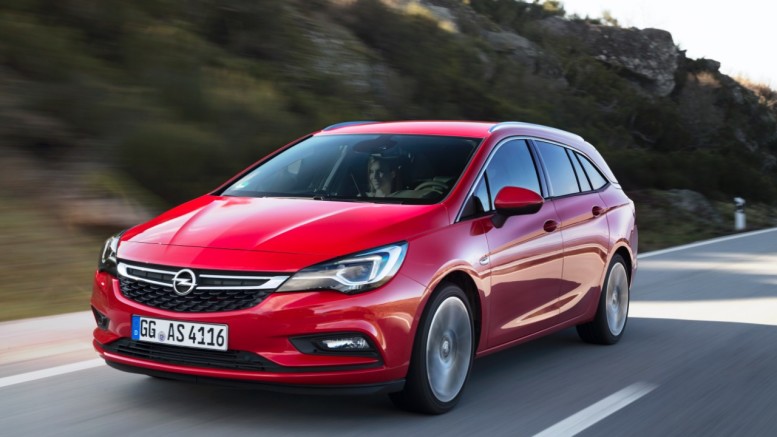

Like the hatch , the Sports Tourer is up there with the best in terms of handling. Steering is direct, body control is good and there’s lots of grip. Brake feel is more progressive than the hatch but still not perfect, and the ride on 17-inch alloys is a bit firm. Road noise isn’t as well suppressed as in the Golf, either.